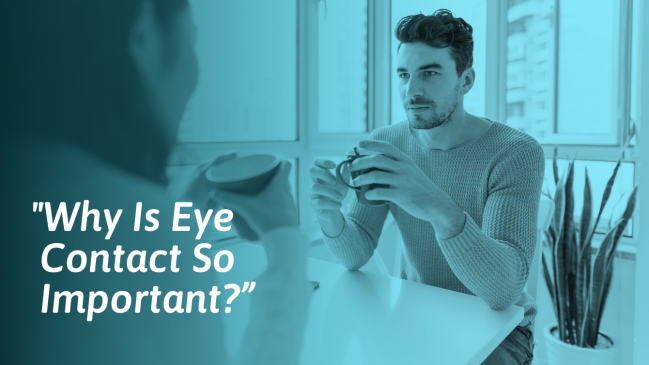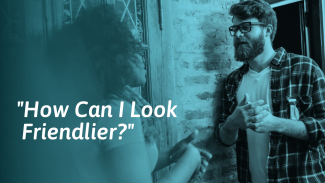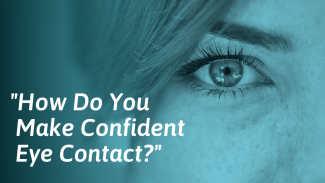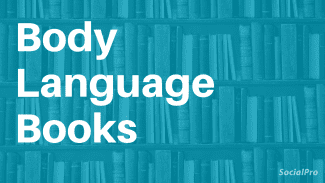“I’m an introvert, and when I feel shy or nervous around someone, I tend to look away or look down during a conversation. How can I improve my eye contact and get better at communicating with people?”
Like facial expressions, body language, and gestures, eye contact is a non-verbal form of communication. All forms of nonverbal communication can either help or hinder communication. Good eye contact also makes others more likely to like and respect you, making it an important tool for building and maintaining relationships.
This article will help you learn more about the power of eye contact and give you tips on how to use eye contact in communication in an effective way.
Sections
- What makes eye contact important in communication?
- How to make good eye contact in conversations
- How to make good eye contact in public speaking
- The connection between eye contact and attraction
- How to interpret different types of eye contact
- Common questions
What makes eye contact important in communication?
1. Why is eye contact important?
Most researchers agree that eye contact is the most important form of non-verbal communication because it has the most impact on how another person feels about you and what you’re saying.[1][2][3] Making too much or too little eye contact can send mixed signals, discredit what you’re saying, or even be interpreted as a sign of disrespect.
2. Eye contact in conversations
During a conversation, you can use eye contact as a tool to help you communicate more effectively. Making eye contact with someone during a conversation is one of the best ways to ensure that:[1][2][3][4]
- Communication is clear and understood by both people
- Both people leave the interaction feeling heard, respected, and understood
- The intended messages are sent and received
- Each person knows what the other thinks and feels about the topic
- You don’t accidentally offend someone
- You can pick up on social cues
- Lines of communication remain open in the future
- People remember you and the things you say
- You know how your message is being received and interpreted
- You give and receive respect to the other person you’re talking to
- You build and maintain good, close relationships with people
- People are honest and open with you
3. Eye contact when speaking
Eye contact can either support or discredit the words you say. When you don’t make good eye contact with someone you are talking to, other people are less likely to listen and understand what you’re saying, and miscommunications are more likely to occur. Eye contact has several functions when you are the one speaking.
When you are speaking to someone, good eye contact helps to:[1][2][3][4]
- Add credibility to what you are saying
- Make you seem more sincere or authentic
- Get and keep the other person’s attention
- Confirm whether or not someone understands you
- Give cues to change or adjust your communication style
- Understand how the other person is responding to what you’re saying
- Add emotional meaning or emphasis to your words
- Adjust your communication style according to social cues
- Give your words more credibility
- Helps people remember more of what you say to them
4. Eye contact when listening
Eye contact is equally helpful when someone else is talking to you. Avoiding eye contact with someone who you’re in a conversation with can send them the message that you aren’t listening to them and can even be seen as rude.
When someone else is speaking, making eye contact with them helps to:[1][2][3][5]
- Show interest in what they are saying
- Prove you are listening and paying attention
- Show respect towards them
- Show them you understand what they’re saying
- Generate trust and closeness with them
- Encourage them to continue the conversation
- Be more open and honest with you
5. How does a lack of eye contact affect communication?
There are many ways that a lack of eye contact can negatively impact communication, making misunderstandings more likely to occur. Not making eye contact with someone in a conversation can also lead people to believe you aren’t listening or interested in what they say and can even offend someone. [1][3]
When you avoid making eye contact with someone you are communicating with, it can:[1][3][4][6][7]
- Make you seem less trustworthy or honest
- Make your words less memorable to them
- Send them the signal that you don’t want to talk
- Make them believe you dislike them
- Signal you aren’t interested or paying attention
- Be interpreted as a sign of disrespect
- Cause you to miss important social and nonverbal cues
- Make you seem passive, insecure, or afraid
6. What does eye contact tell you about a person?
A person’s eye contact and gaze can also tell you a lot about their personality, status, and confidence level. We can also use eye contact to figure out how someone feels and whether they like or dislike us based on their eye contact.[1]
Here are some of the different things you may be able to learn about someone based on how much or how little eye contact they make:[3][6][7][8]
- Whether a person is confident or insecure
- What kind of personality someone has (e.g., introverted, open-minded, etc.)
- How much authority or power someone has
- How interested a person is in a conversation
- Whether a person or their words can be trusted
- How honest or sincere a person is being
7. How does eye contact affect relationships?
Compared to other forms of nonverbal communication, eye contact is believed to have the most significant role in how much other people like and trust you.[1] Your eyes send strong emotional signals to other people that can make them feel either closer to you or more distant from you.
- How persuasive someone is
- What intentions a person has
- If a person is aggressive or friendly
- Whether there is a potential sexual attraction
- If there is mutual interest in becoming friends
8. Individual and cultural differences in eye contact
Depending on a person’s background, culture, and individual preferences, some people are more or less comfortable with eye contact. In some instances, people will become uncomfortable or threatened when you make too much eye contact, and in other cases, they will be offended when you avoid eye contact. Social cues can help you understand when a person is comfortable or uncomfortable with the amount of eye contact you’re making with them.
How to make good eye contact in conversations
How much eye contact you make and how long you hold someone’s gaze will depend on the type of interaction and also the kind of relationship you have with the person. Depending on the situation, making too much or too little eye contact in conversations can send the wrong message to someone.
1. When to make more or less eye contact
Generally, you will make more eye contact with people you are closest to and in high-stakes conversations than you will in more casual interactions with strangers or acquaintances.[3]
Aim for more or less eye contact depending on the situation, and use the chart below as a guide:
| Use more eye contact | Use less eye contact |
|---|---|
| With close friends and family | With strangers or acquaintances |
| In one-on-one conversations | In group conversations or settings |
| In important interviews or formal interactions | In informal or casual social settings |
| When in a leadership/authority position | When talking with an authority/leader figure |
| When you need to make an impact | With strangers in public |
| When making a first impression | With people who you aren’t talking to |
| When trying to form a close relationship | When you want or need to end an interaction |
| When someone is responding warmly to you | When someone seems uncomfortable |
2. Eye contact when speaking vs. listening
Typically, you should try to make more eye contact when you are listening and less when you are speaking unless it is a particularly important conversation or you’re delivering a speech. Some professionals advise using the 50/70 rule, which is to aim to make eye contact 50% of the time you are speaking and 70% of the time you are listening.[8]
3. Eye contact combined with other nonverbal communication
Eye contact should always be used in combination with other nonverbal communication skills to make sure you are sending the message you intend to send. Here are some tips on how to combine eye contact with other nonverbal cues:
- Make eye contact and nod when someone is speaking to show interest
- Smile while making eye contact with a stranger or acquaintance to give friendly vibes
- Use expressions while making eye contact to demonstrate emotion in conversations
- Make more direct eye contact when giving praise, compliments, or good news
- Make less direct eye contact when giving negative feedback or bad news to someone
- Raise your eyebrows and look at a person to give a “nudge” or signal someone in a group
How to make good eye contact in public speaking
Because it’s common for people to feel nervous when speaking in public or in front of large crowds, some people avoid making eye contact with the audience.[7][8] Unfortunately, this can make your speech or presentation a lot less impactful.
1. What is the importance of eye contact in public speaking?
When you are delivering a speech or presenting in public, making eye contact helps you be seen as an effective and engaging speaker.[3][8]
When you avoid making eye contact during a public speech, you are more likely to:
- Struggle to keep the audience interested and engaged
- Miss social cues that can help you improve your speech
- Seem less credible and trustworthy to the audience
- Appear nervous, which can make the audience feel uncomfortable
- Miss chances to engage the audience in the presentation or speech
- Run into problems like distracted listeners or side conversations
2. Eye contact do’s and don’ts in public speeches
There are certain do’s and don’ts when it comes to making eye contact during a public speech or presentation. Some of these are aimed at helping you feel more comfortable and less nervous, while others are intended to help you deliver your speech effectively.
Here are some tips on how to make good eye contact in public speaking:[8]
- Find friendly faces to look at (people who are nodding and smiling or people you know)
- “Shrink the room” by looking at those closest to you to feel more comfortable
- Look at the foreheads of people in the crowd instead of in their eyes if you’re nervous
- Hold someone’s gaze for a sentence before moving onto another person
- Don’t dart your eyes, look down, or avoid any eye contact with the audience
- As you get more comfortable, make more direct eye contact with the audience
- Use eye contact to encourage participation and interaction with your audience
- Make more eye contact and speak slowly to emphasize important parts of the speech
- Ask for input, questions, or interaction when the audience looks bored or distracted
- Look for raised eyebrows, confused looks, or people looking at each other to know when you need to go back or clarify something you said
The connection between eye contact and attraction
Eye contact plays a key role in sexual attraction and intimacy. Knowing what kinds of eye contact are used to convey sexual interest or attraction can help you understand when someone is interested in you and also can prevent you from accidentally sending mixed signals to people.
1. Eye contact signals sexual attraction
Eye contact is often used to signal sexual interest and attraction and to check if the attraction is mutual. In public or social settings, making prolonged eye contact with a stranger is often a signal of mutual sexual interest and attraction.[9]
If you are interested and attracted to the person looking at you, holding their gaze makes it more likely they will approach you. If you are not interested or are in a committed monogamous relationship, holding the gaze of a stranger for too long can invite unwanted advances.
2. Eye contact & flirting
If you are approached by someone who you are sexually attracted to or interested in, eye contact is one of the best ways to send clear signals to the other person. Holding their gaze for a few seconds, looking away briefly, looking back, and smiling is often interpreted as flirting.[9]
Even looking at someone you are attracted to across a crowded room to catch their gaze can be a way of flirting with them, especially if you’ve had other flirtatious interactions with one another.[10] This kind of flirting is often recognized by other people, so avoid these kinds of obvious cues when you are trying to be discreet.
3. Eye contact during sex
Eye contact is also linked to sexual and romantic intimacy.[10] Locking eyes with someone during sex or foreplay often increases mutual feelings of attraction. Tracking facial expressions during sex can also let you know if they are enjoying sex. In these ways, making eye contact during sex is a good way to be an attentive sexual partner.
How to interpret different types of eye contact
Eye contact etiquette is not the same in all situations, and different kinds of eye contact can mean different things. Knowing the basics of eye contact etiquette and when to adjust how much eye contact you make is key to using this tool effectively.[7][10]
1. Etiquette of eye contact
In closer relationships, making eye contact with someone for 4-5 seconds before glancing away is normal, but this is way too long to look at a stranger or someone who you aren’t in a conversation with.[3][8] The closer you are to someone, the more acceptable it is to make longer periods of eye contact with them.[3]
Avoid making too much eye contact with strangers, as this can make them feel threatened or insecure. Make more eye contact with anyone you’re directly talking to, especially if it’s a 1:1 conversation. Watch for signs that they are comfortable, and adjust how much eye contact you make based on their body language.
Make more eye contact during high-stakes, formal, or professional interactions. For instance, eye contact in interviews or work presentations helps you make a good, lasting first impression.[1][3] Good eye contact in a professional interaction also makes people more likely to see you as credible, trustworthy, and persuasive.
2. Understanding different types of eye contact cues
Because eye contact can have a multitude of functions in social interactions, it’s good to be able to interpret different cues people give you with their eyes. Below are some examples of eye contact cues and what they may mean in social interactions.[2][10]
- A speaker looking at you in a group setting can indicate they are directing their message to you or want you to chime in
- Someone looking at you and pausing in a conversation can be an indication they want you to take a turn talking
- Someone looking at you across the room in a social event can indicate they are interested in talking to you or want you to come to them
- A stranger looking at you and locking eyes can signal an attraction or interest in starting a conversation
- Someone looking at you in the workplace, a meeting, or presentation can indicate they have a question or comment
- Confused or puzzled looks during a conversation can indicate the need to clarify or re-state your message
- Someone smiling and nodding while making eye contact with you during a conversation is often a sign they like you and are enjoying the conversation
- Someone looking down, to the side, or darting their eyes away in a conversation can signal they feel insecure or it is not a good time to talk
3. Social cues to adjust eye contact
Below is a guide to reading and picking up on social cues that may indicate a need for less eye contact and cues that indicate you are making the right amount of eye contact:[8][10]
| Signs of discomfort | Signs of comfort |
|---|---|
| Averting their eyes or looking away/down | Meeting/matching your gaze |
| Fidgeting or seeming restless | Sitting in an open/comfortable position |
| Checking their watch, phone, or the door | Eye contact and smiling or nodding |
| Looking elsewhere when they talk to you | Looking at you when you’re talking |
| Bad or infrequent eye contact | Meeting your eyes when they speak to you |
Final thoughts
Eye contact is often seen as one of the most important aspects of communication.[3] Making too much eye contact or not enough eye contact can violate unspoken social norms and rules, offend someone, or make them uncomfortable. Learning basic eye contact etiquette can help you, but it’s also helpful to use your eyes to look for social cues and signs. Using your eyes can help you become better at communicating, relating, and connecting with other people.[1][2][3]
Common questions
Here are some answers to the most commonly asked questions about eye contact.
Is eye contact a sign of confidence?
Yes. People who avert their eyes or avoid direct eye contact are often perceived as being insecure, nervous, or lacking in confidence.[1] Making too much eye contact or staring at someone can even signal someone who is too confident and may be interpreted as a sign of aggression.[3]
What does prolonged eye contact mean?
Prolonged eye contact can mean different things depending on the situation but does tend to send a strong message. For example, locking eyes with a stranger can be perceived as threatening or hostile or can be interpreted as a sign of sexual interest.[9][10]
Why do I feel uncomfortable with eye contact?
Eye contact can sometimes trigger self-consciousness or bring up personal insecurities.[7] You may be more uncomfortable with eye contact if you are shy, introverted, or if you’re in an unfamiliar setting.
Is avoiding eye contact a sign of anxiety?
Avoiding eye contact can be a sign of anxiety, but it can also signal disinterest or dislike for a person or a conversation.[3][7][10] In some cases, people avoid eye contact for less personal reasons, like when they’re distracted in a conversation or have something on their mind.
How does eye contact show emotions?
A person’s eyes can signal their emotions, so when they make eye contact, we can often tell what they are feeling. Research shows that most people are good at reading others’ eyes, picking up easily on various feelings, including boredom and playfulness.[11]





dear sir,
Please write 80 word short notes on the following points:
1. How is Eye Contact important in the process of business communication?
2. How is Calm and Collected attitude important in the process of business communication?
3. How is Precise and Clear language important in the process of business communication?
4. How is Avoiding Contradictory information important in the process of business communication?
5. How is Choosing the Right Words important in establishing appropriate tone in the process of business communication?